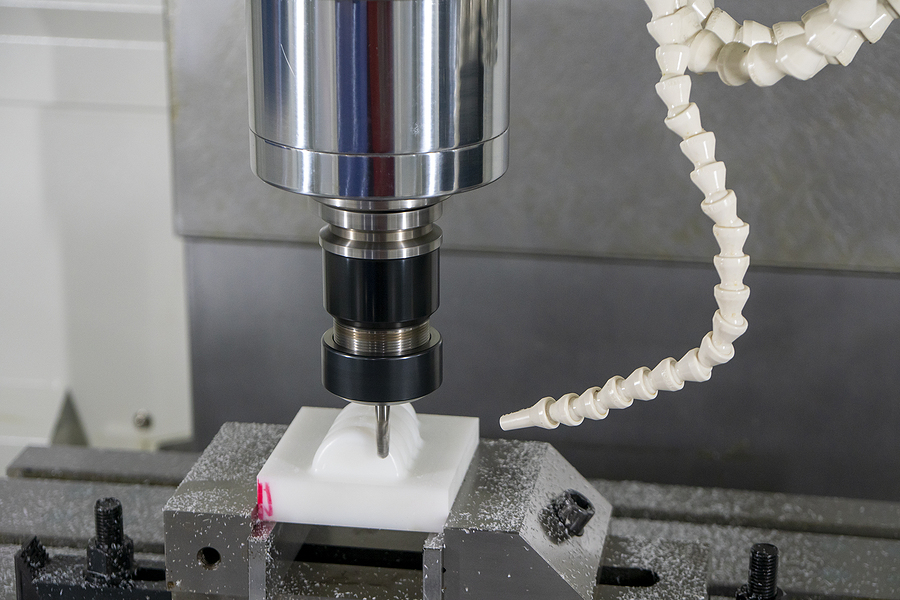While often used interchangeably with finishing processes, secondary machining processes are done after primary manufacturing methods such as injection molding, thermoforming, and CNC machining.
As the final stage in manufacturing, it helps improve the surface finish, aesthetics, dimensional integrity, and tolerance of molded parts when they emerge from the press.
The Secondary Machining Processes
Secondary machining is a cost-effective strategy for the production of workpieces that involves some if not all the following processes:
CNC Machining
This automated manufacturing process controls a wide range of complex machinery to create different molded prototypes. This can include lathes, grinders, mills, and turning.
Milling
During face or peripheral milling operations, a cutting tool uses multi-point rotary cutters to carve deep threads, slots, and gear teeth on a workpiece. As a secondary machining process, milling is considered a “finishing coat.” This is because it helps define features like contours, holes, pockets, and slots.
Turning
This machining process is either done manually or automatically. In most cases, a lathe is the machine of choice. The cutting tool moves in a linear motion as the workpiece rotates to create a final tube-shaped piece. CNC allows for high production efficiency and consistency. Speeds and tool movements can be programmed into a computer and then sent to the lathe for completion.
Drilling
A Computer Numerical Control (CNC) secondary machining process utilizing a rotating cutter with cutting edges to produce holes on workpieces. While drilling procedures are primarily done in drill presses, they can also work on lathes or mills.
Grinding
Also known as surface grinding, this machining operation uses a powdered abrasive wheel, belt, sheet, or paste. This produces a fine tolerance surface finish. Unlike other processes, grinding is thought to be a more precise tolerance modification method of using an abrasive turning wheel.
Tapping
This process employs a cylindrical or conical thread-cutting tool to create grooves into the inside surface of a drilled hole. Through this a screw cap or bolt can be fitted. Tapping can be programmed on a CNC lathe to make for a highly efficient and easy threading process.
Advantages of Using Secondary Machining Innovation
Machining a perfectly precise and functional workpiece requires attention to detail and experience in the machining processes mentioned above. While traditional machining still plays a role in manufacturing, the advent of Computer Numerical Control (CNC) has significantly improved processes. This is especially true where consistency and efficiency are required in large production runs.
With plastic parts assemblies becoming more common, a lot goes into consideration when designing an injection mold that will ultimately be part of an extensive assembly. Full-service contract manufacturers of custom plastic injection molded parts and assemblies can also employ the latest technology to perform post-molding operations, including ultrasonic welding, inserting, and conditioning.
When you’re ready to design custom plastic components, consider the expertise of a full-service contract manufacturer to enjoy the following benefits:
- Machinable plastics come in various shapes, colors, and sizes to fit your design and application preferences.
- Plastics are easy to machine and often less expensive than their metal counterparts. Therefore, they can be used for lightweight prototyping.
- CNC machining is a high-precision, high-quality, and fast-paced production process used to produce a wide range of plastic pieces and parts at half the time and price.
- You can liaise with an expert in all things plastic to help you choose the suitable plastic material that fits your project needs.
- When manufacturing many identical moldable plastics that need to be mass-produced, you can select injection molding to meet the demand for high-performance plastic parts.
As a full-service contract manufacturer of custom plastic injection molded parts and assemblies, our goal at Proto Plastics is to combine innovative technologies and years of experience to provide the best solutions in plastic machining workpieces. Contact us today to discuss how to include secondary machining processes in your upcoming project.
